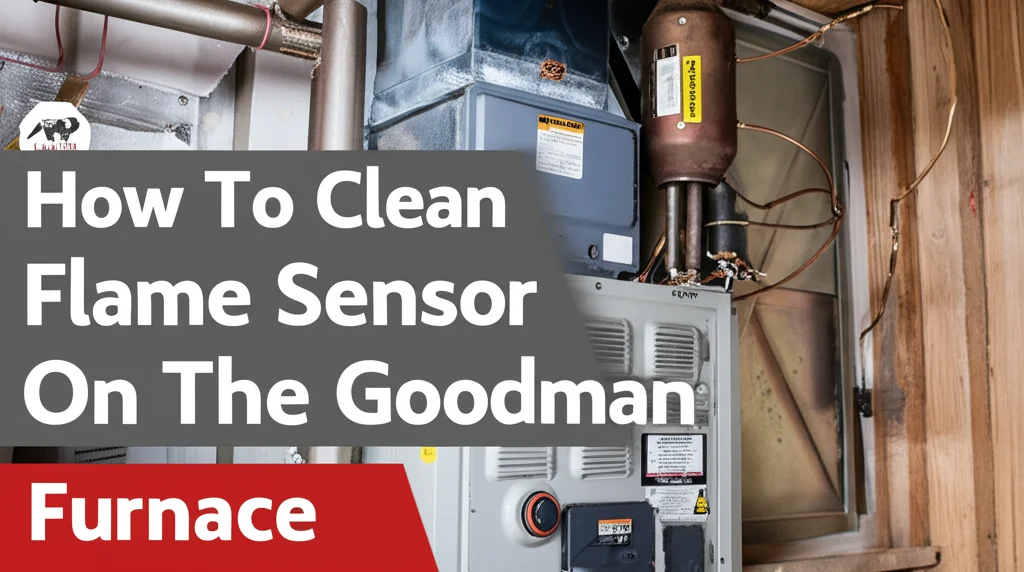· Home Improvement · 6 min read
How To Clean The Flame Sensor On The Goodman Furnace

A Reliable Flame Sensor: Keeping Your Goodman Furnace Running Smoothly
Have you noticed your Goodman furnace shutting off unexpectedly, even during the coldest months? A common culprit is a dirty flame sensor. This small but vital component ensures your furnace operates safely and efficiently. Cleaning the flame sensor is often a simple DIY task that can save you a costly service call. This article will guide you through the process, step-by-step, so you can get your furnace back to providing consistent warmth. We’ll cover everything from safety precautions to the cleaning process itself, ensuring you feel confident tackling this essential maintenance task.
Takeaway:
- Regularly cleaning your Goodman furnace’s flame sensor improves heating efficiency.
- A dirty flame sensor can cause intermittent heating or furnace shutdowns.
- Cleaning is a relatively simple DIY project, saving you money on repairs.
What Does a Flame Sensor Do?
The flame sensor is a safety device that detects the presence of a flame in your furnace. If the sensor doesn’t detect a flame, it signals the gas valve to shut off, preventing a dangerous buildup of gas. Over time, carbon buildup can accumulate on the flame sensor, interfering with its ability to accurately detect the flame. This leads to the furnace shutting down as a safety precaution, even when there is a flame present.
Safety First: Before You Begin Cleaning
Before you even think about touching your furnace, safety is paramount. Working with gas appliances requires caution. First, turn off the power to your furnace at the breaker box. This is absolutely crucial to prevent electrical shock. Next, locate the gas shut-off valve near the furnace and ensure it’s easily accessible in case of emergency. It’s also a good idea to have a carbon monoxide detector installed and functioning properly in your home. Finally, if you are uncomfortable with any part of this process, don’t hesitate to call a qualified HVAC technician.
Locating the Flame Sensor in Your Goodman Furnace
Finding the flame sensor is the first step. It’s typically located near the burners, often a single metal rod protruding into the flame path. Goodman furnaces usually have a single flame sensor, but the exact location can vary slightly depending on the model. Consult your furnace’s manual if you’re unsure. Generally, you’ll need to remove the furnace access panel to gain visibility. Remember to take a picture before disconnecting any wires – this will help you reassemble everything correctly.
Gathering Your Cleaning Supplies
You won’t need a lot of fancy tools for this job. In fact, you likely have everything you need already. Here’s what you’ll need:
- Screwdriver: To remove the access panel and potentially the flame sensor itself.
- Fine-grit sandpaper or steel wool (0000 grade): This is the key to removing the carbon buildup.
- Clean cloth: For wiping the sensor and surrounding areas.
- Vacuum cleaner with brush attachment: To remove any loose debris.
- Optional: Electrical contact cleaner: For a more thorough cleaning (use sparingly).
Avoid using harsh chemicals or abrasive cleaners, as these can damage the flame sensor.
The Cleaning Process: Step-by-Step Instructions
Now for the main event! Start by carefully disconnecting the wire connected to the flame sensor. Gently remove the flame sensor from its bracket. If it’s held in place by a screw, loosen it and carefully pull the sensor out. Next, using the fine-grit sandpaper or steel wool, gently rub the sensing element (the metal part that sits in the flame). Apply light pressure and rub along the length of the sensor. You’ll likely see black carbon residue coming off. Continue until the sensor is clean and shiny. Avoid bending or damaging the sensor during this process. Once clean, wipe the sensor with a clean cloth to remove any remaining residue. If you’re using electrical contact cleaner, spray a small amount onto the cloth and wipe the sensor – do not spray directly onto the sensor.
Reassembling and Testing Your Furnace
With the flame sensor clean, it’s time to put everything back together. Carefully reinsert the flame sensor into its bracket and secure it with the screw (if applicable). Reconnect the wire to the flame sensor, ensuring it’s firmly attached. Replace the furnace access panel and secure it with the screws. Now, turn the power back on at the breaker box. Turn the furnace on and observe its operation. It should now ignite and stay lit without shutting off prematurely. If the problem persists, there may be another issue, and you should consult a qualified HVAC technician.
Troubleshooting: What If Cleaning Doesn’t Work?
Sometimes, cleaning the flame sensor isn’t enough to resolve the issue. Here are a few things to consider:
- Gas Supply: Ensure your gas supply is turned on and there are no leaks.
- Wiring Issues: Double-check all wiring connections to the flame sensor and control board.
- Control Board Problems: A faulty control board can also cause the furnace to shut down.
- Dirty Burners: Dirty burners can disrupt the flame pattern and affect the flame sensor’s ability to detect the flame.
If you’ve checked these things and the furnace still isn’t working, it’s time to call a professional.
Frequently Asked Questions (FAQ)
Q: How often should I clean my flame sensor?
A: It’s generally recommended to clean your flame sensor at least once a year, or more frequently if you notice your furnace shutting off intermittently. Regular maintenance can prevent issues and extend the life of your furnace.
Q: Can I use anything other than sandpaper to clean the flame sensor?
A: While sandpaper is the most common method, you can also use very fine steel wool (0000 grade). Avoid using abrasive cleaners or harsh chemicals, as these can damage the sensor.
Q: What if the flame sensor is severely corroded?
A: If the flame sensor is severely corroded, cleaning may not be enough. In this case, you’ll need to replace the flame sensor.
Q: Is it normal for my furnace to shut off occasionally?
A: Occasional shutdowns can be normal, especially during startup. However, if your furnace is shutting off frequently, it’s a sign of a problem that needs to be addressed.
Q: What does a failing flame sensor sound like?
A: A failing flame sensor doesn’t typically make a distinct sound. The symptom is usually the furnace cycling on and off repeatedly, or failing to stay lit.
Conclusion: Maintaining a Warm and Efficient Home
Cleaning the flame sensor on your Goodman furnace is a simple yet effective way to maintain a warm and efficient home. By following the steps outlined in this guide, you can often resolve common furnace issues yourself, saving you time and money. Remember to prioritize safety and consult a qualified HVAC technician if you’re uncomfortable with any part of the process. Regular maintenance, including cleaning the flame sensor, will help ensure your Goodman furnace operates reliably for years to come. Don’t let a dirty flame sensor leave you in the cold – take a few minutes to clean it and enjoy the peace of mind that comes with a properly functioning heating system.




